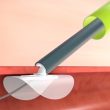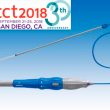Experts still won’t agree on whether to carry out randomized trial to put an end to this discussion, but it seems clear that balloon expandable TAVR is valid only for certain anatomies. TAVR in real world bicuspid valve populations is associated with similar outcomes at 30 days and one year when compared against cohorts<a href="https://solaci.org/en/2019/03/22/acc-2019-tavr-in-bicuspids-is-safe-and-feasible-in-real-world-patients/" title="Read more" >...</a>
Transcarotid Approach for Transfemoral in TAVR
Courtesy of Dr. Carlos Fava. At present, the transfemoral is the preferred access site in TAVR, for it has been shown to present fewer complications. However, whenever not feasible, we can resort to other approaches. These include the subclavian, the transapical, the transcaval, the transaortic, and the transcarotid. This last one has been studied few<a href="https://solaci.org/en/2019/03/15/transcarotid-approach-for-transfemoral-in-tavr/" title="Read more" >...</a>
Mechanical Thrombectomy in Stroke Could Have Worse Results in Low Volume Centers
The number of centers that are starting endovascular stroke therapy (EST) to treat acute stroke is growing fast, with a significant increase of cases in low volume centers. Interventional neurologists are not able to cover the high demand and interventional cardiologists are always ready to learn something new. Is this right? Should interventional cardiologists treat<a href="https://solaci.org/en/2019/02/14/mechanical-thrombectomy-in-stroke-could-have-worse-results-in-low-volume-centers/" title="Read more" >...</a>
The Most Relevant Articles of 2018 in Peripheral Vascular Disease
1- What’s New in the European Guidelines on Peripheral Arterial Disease Since the last version of the European guidelines on the diagnosis and treatment of peripheral arterial disease in 2011, there have been many trials and registries that warrant guideline adjustments in many aspects. The first novelty is the teamwork that gave way to these<a href="https://solaci.org/en/2019/02/04/the-most-relevant-articles-of-2018-in-peripheral-vascular-disease/" title="Read more" >...</a>
The Physiopathology Behind Valve Degeneration in TAVR
The degeneration of transcatheter biological valves clearly depends on time and starts with thrombus generation and subsequent histological changes resulting in valve failure (due to regurgitation, stenosis, or both). Thrombus formation is the first change, observed early in computerized tomography (CT) scans after implantation. Most times it is completely asymptomatic, which leaves many of us<a href="https://solaci.org/en/2019/01/18/the-physiopathology-behind-valve-degeneration-in-tavr/" title="Read more" >...</a>
Percutaneous Closure Systems Are Safe in TAVR and Aneurysms
Courtesy of Dr. Carlos Fava. Currently, one of our medical challenges is to conduct procedures requiring access with large introducer sheaths in a simpler way, without requiring surgical intervention and closing with percutaneous devices while maintaining procedural quality and safety. There are several devices, but they require a learning curve and the only information available comes<a href="https://solaci.org/en/2019/01/15/percutaneous-closure-systems-are-safe-in-tavr-and-aneurysms/" title="Read more" >...</a>
TCT 2018 | NEOPRO: A Registry for Acurate neo and Evolut PRO
The purpose of this registry was to compare short-term clinical events and echocardiographic findings in two self-expanding valves used with transfemoral access, Acurate neo and Evolut PRO. The registry included a retrospective follow-up of 1551 patients, among whom 1263 received an Acurate neo valve and 288 received an Evolut Pro valve. The procedural success rates according to VARC-2 criteria were<a href="https://solaci.org/en/2018/10/04/tct-2018-neopro-a-registry-for-acurate-neo-and-evolut-pro/" title="Read more" >...</a>
See the presentations of the 9th José Gabay Fellow Course
We are deeply thankful to all interventional physicians who, motivated by their great scientific and educational vocation, presented their works at the “José Gabay” Course. Read the presentations below: Module I: Fundamentals and Basic Elements. Leiva Pons, José Luis. “Vascular Closure Devices. Step by Step.” (Spanish version) García García, Hector. “Current Status of Coronary Intervention:<a href="https://solaci.org/en/2018/09/14/see-the-presentations-of-the-9th-jose-gabay-fellow-course/" title="Read more" >...</a>
EuroPCR 2018 | SAPIEN 3 in bicuspids
First generation TAVR procedures performed on patients with bicuspid aortic valve stenosis have rendered suboptimal outcomes. In addition, studies on new generation devices, such as the SAPIEN 3, have systematically excluded these patients from their protocols. Therefore, we are missing information about TAVR on bicuspid aortic valve stenosis patients. This study compared SAPIEN 3 TAVR<a href="https://solaci.org/en/2018/05/30/europcr-2018-sapien-3-in-bicuspids/" title="Read more" >...</a>
Liver Failure as a Challenge for TAVR
Although surgical risk scores do not include liver failure (LF), patients who suffer from it and undergo cardiovascular surgery present high rates of morbidity and mortality. This is due to alteration of cardiac function, increased infection susceptibility, gastrointestinal complications, and increased bleeding. As regards transcatheter aortic valve replacement (TAVR), these patients have not been included<a href="https://solaci.org/en/2018/05/03/liver-failure-as-a-challenge-for-tavr/" title="Read more" >...</a>









